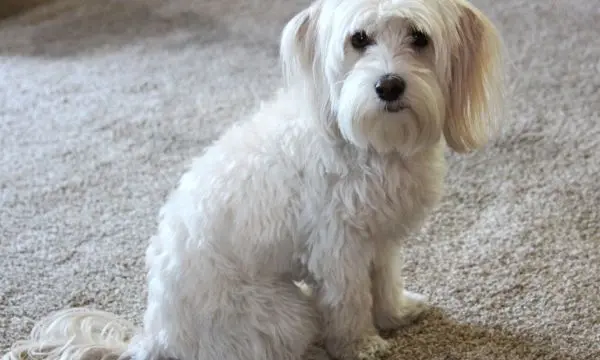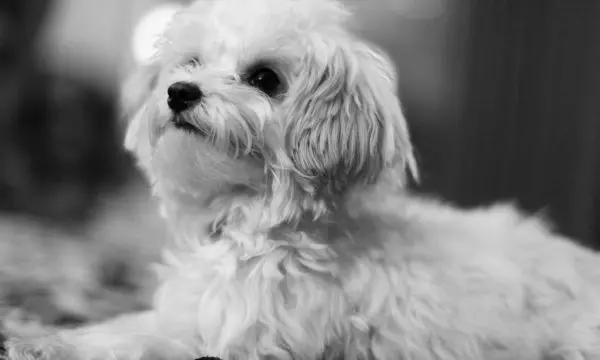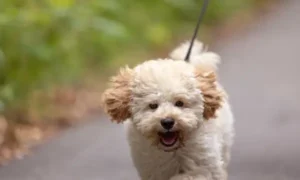As delightful as Maltipoos are, their lovable and lively nature can sometimes result in behavior hiccups that need addressing.
These fluffy companions are known for their affectionate and friendly temperament, but like any dog breed, they can face a few common behavioral issues.
Here is a guide to the top five Maltipoo behavior problems and how to manage them effectively.

1. Excessive Barking
Barking is a dog’s natural way of communicating, and Maltipoos, known for their high energy and playful nature, are no exception.
However, their enthusiasm can sometimes cause them to bark excessively. By gaining a deeper understanding of what triggers their barks, such as unfamiliar sounds or perceived threats, dog owners can effectively manage and address this behavior.
Whether it’s providing appropriate mental and physical stimulation or implementing positive reinforcement training techniques, taking proactive measures can help Maltipoos channel their energy in more constructive ways and maintain a peaceful environment for both the dog and its human companions.
Causes of Excessive Barking in Maltipoos
Maltipoos can bark excessively due to various reasons, such as:
- Boredom or loneliness
- Fear or alerting their owner to perceived threats
- Attention-seeking behavior
- A response to other dogs or animals
Tips to Manage and Reduce Barking
To curb this behavior, consider the following tactics:
- Regular exercise and mental stimulation to prevent boredom
- Socialization to reduce fear of other dogs and strangers
- Training a ‘quiet’ command using positive reinforcement techniques
- Understanding when the barking is justified and when it’s not, to avoid reinforcing it inadvertently
2. Separation Anxiety
Maltipoos, a crossbreed of Maltese and Poodle, are known for forming a profound and deep attachment with their owners.
This strong bond can sometimes result in separation anxiety when these adorable furry companions are left alone for extended periods of time.
Signs of Separation Anxiety in Maltipoos
Look out for these signs:
- Excessive barking or howling shortly after you leave
- Destructive behaviors, like scratching at doors
- Pottying indoors, despite being house trained
- Pacing or restlessness just before you leave or when they sense you’ll return
Strategies to Help Alleviate Separation Anxiety
Addressing separation anxiety requires patience and the right approach:
- Gradual ‘departure training’ can desensitize your dog to your leaving and returning
- Using cues and objects that they associate with positive things can create a calm environment
- Avoid making a fuss over departures and arrivals
- Consistency in daily routines to provide a sense of security for your Maltipoo
3. House Training Challenges
Maltipoos, known for their intelligence and charm, can sometimes face challenges when it comes to house training.
However, with patience, consistency, and a deep understanding of their needs, these adorable hybrid dogs can overcome these hurdles and become well-behaved and loyal companions.
It is important to provide them with proper guidance and positive reinforcement to help them master their house training skills and thrive in a loving home environment.
Common House Training Issues Specific to Maltipoos
Maltipoos may exhibit the following house training challenges:
- Difficulty holding urine due to their small bladders
- Reluctance to go outdoors in extreme weather
- Submissive or excitement urination in certain situations
- Hiding to eliminate, a sign that they might feel punishment or discomfort associated with the act
Effective House Training Techniques for Maltipoos
Here’s how to implement effective house training with your Maltipoo:
- Establish a regular feeding and potty schedule
- Use positive reinforcement and a set command for elimination
- Supervise your Maltipoo closely to catch and correct accidents
- Avoid scolding for accidents and instead focus on preventing them through a consistent routine

4. Leash Reactivity
Maltipoos, a crossbreed between Maltese and Poodle, are known for their overall friendliness and sociability.
However, it is important to note that they may occasionally exhibit reactivity while on a leash. This behavior can catch their owners off guard and lead to feelings of surprise and distress.
It is crucial for owners to be aware of this tendency and take appropriate measures to manage and address any leash-related reactivity in their Maltipoos.
Understanding Leash Reactivity in Maltipoos
Leash reactivity may be due to:
- Frustration at not being able to reach a perceived threat
- Fear or anxiety, especially if not well-socialized
- Startle response to sudden stimuli while on a leash
Training Methods to Address Leash Reactivity
To tackle leash reactivity, adopt these techniques:
- Use desensitization and counter-conditioning to change your dog’s response to the stimulus
- Teach your dog to focus on you with a ‘watch me’ command
- Increase the distance from the stimulus and gradually work your way closer, rewarding calm behavior
- Patience and consistent training sessions with shorter increments
5. Resource Guarding
Maltipoos, like many dogs, may display resource guarding, a behavior where they protect a valued item from others, sometimes even aggressively.
This behavior can manifest when they possess high-value items such as food, toys, or even their favorite spot on the couch.
It is important for owners to understand and address this behavior through proper training and socialization to ensure a harmonious and safe environment for everyone involved.
What is Resource Guarding and Why Maltipoos May Exhibit It
Resource guarding might occur due to the following reasons:
- Instinct from their wild ancestors to protect their food
- Fear that their valuable possession may be taken away
- Not being taught to share or have boundaries early in their life
Steps to Manage and Prevent Resource Guarding Behavior
It’s crucial to approach resource guarding with caution and avoid confrontations. Instead:
- Trade up for the item your dog is guarding to teach them that giving up a possession leads to something better
- Avoid situations that trigger guarding behavior
- Work with a professional trainer to safely and effectively manage the guarding behavior
- Slowly introduce new ways for your dog to earn special items, associating them with positive experiences
Conclusion
Understanding and addressing these behavior problems is not just about keeping the peace at home, it’s about creating a harmonious environment that allows your Maltipoo to thrive.
Professional guidance may be necessary as you navigate these challenges, and remember, patience and positive reinforcement go a long way.
By staying attuned to your Maltipoo’s needs and providing a supportive environment, you can overcome these behavior hurdles and strengthen the bond with your canine companion.








